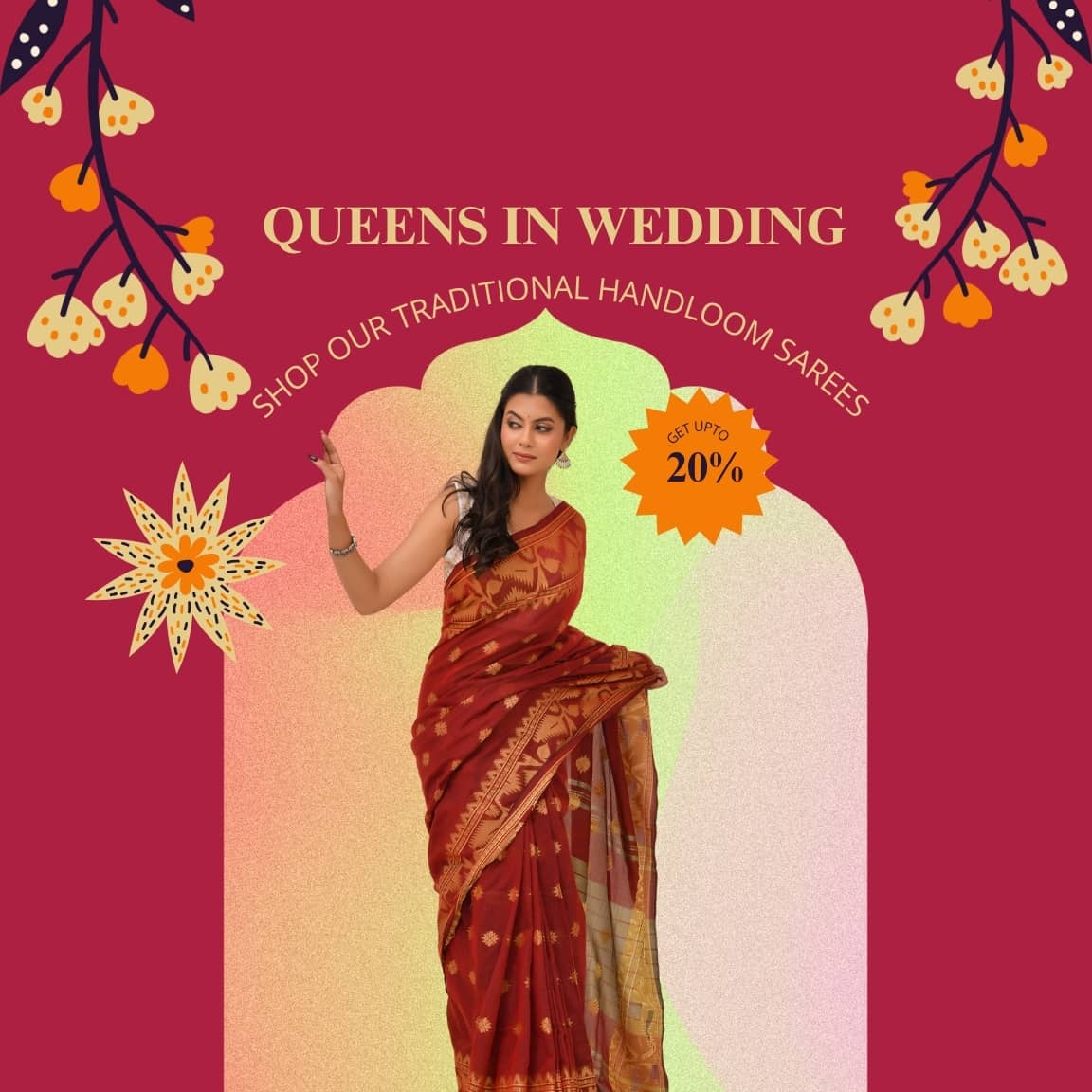Why Does Weather Matter When Choosing Sarees?
Sarees are not just about fashion. Each type of saree was originally crafted with a specific weather in mind. When it comes to sarees, one size does not fit all especially in a country with sharp seasonal shifts. The fabric that feels like heaven on your skin in May may suffocate you in June’s humidity, and the silk that makes you glow at a December wedding won’t help in April’s dry heat.
This guide breaks down which saree to wear in summer, winter, spring, and autumn with researched fabric recommendations, styling tips, and practical care advice.
Why Is This Even a Question?
It matters because every fabric behaves differently in different climates. Knowing this before you search for the best saree for a summer wedding will save you both discomfort and confusion.
A cotton saree that feels light and airy in May can feel too thin in December, while a heavy Banarasi silk that keeps you warm in winter can be unbearable in the heat. That’s why it’s important to understand how saree fabrics like cotton, silk, linen, chiffon, or tussar react to temperature and humidity. When you know which saree works best in summer, winter, spring, or autumn, you can enjoy both elegance and comfort without compromising your look.
You can explore our super comfortable and light handloom collection here
Summer You: Best Sarees for Summer (Light, Airy & Breathable)
When temperatures soar, your best friends are fabrics that breathe:
-
Cotton sarees - Handloom cotton, mulmul, khadi. They wick away sweat and let your skin breathe.
-
Linen sarees - Crisp drape, great for office wear, and keep you fresh.
-
Chiffon & Georgette sarees - Perfect for summer weddings or parties, as they are light and flowy.
-
Organza sarees - For festive occasions where you want elegance without heaviness.
Styling tips:
-
Stick to pastels, whites, and light shades (they reflect heat).
-
Opt for minimal embroidery or thread work.
-
Use sleeveless or breathable cotton-linen blouses.
-
If humidity is high, avoid polyester blends that trap sweat.
Quick picks:
-
Office: simple cotton or linen sarees.
-
Wedding guest: chiffon, organza, or light georgette saree.
Wear what is light on your skin. Explore our Everyday Classics Category. Sarees that keep you moving every day.
Winter You: Best Sarees for Winter (Warm, Rich & Elegant)
Winter is silk season. The chill in the air gives you the perfect excuse to bring out heavier weaves:
-
Kanjeevaram & Banarasi silk sarees - Thick, regal, and warm. Ideal for weddings and receptions.
-
Velvet blend sarees - Dramatic and insulating, perfect for winter nights.
-
Tussar silk sarees - Slightly rustic but naturally warm; good for both day and evening events.
Styling tips:
-
Go for jewel tones: maroon, emerald, navy, royal blue.
-
Pair sarees with pashmina shawls, silk jackets, or long coats draped with the pallu.
-
Full-sleeve blouses or brocade jackets add warmth while staying stylish.
Quick picks:
-
Winter wedding guest: Banarasi silk saree with embroidered shawl.
-
Day event: Tussar silk saree with minimal jewellery.
Explore our hand zari work, find trendy, minimalist and comfortable Timeless Textures category.
Sarees for Spring (Fresh, Floral & Festive)
Spring is all about celebrating colour, freshness, and joy. Choose fabrics that balance comfort and style:
-
Organza sarees - Light and sheer, perfect for floral prints.
-
Cotton-silk blends - Comfortable with a subtle shine.
-
Lightweight silk sarees - Ideal for weddings and pujas.
Styling tips:
-
Florals, digital prints, and pastel shades shine in spring.
-
Go for playful jewellery - oxidised silver or floral sets.
-
Hairstyles: loose waves or flowers in the hair complement the vibe.
Sarees for Autumn (Earthy, Elegant & Festive)
Autumn marks the festive season in India with Diwali, Durga Puja, Karva Chauth. Fabrics should balance mild coolness with a festive look:
-
Tussar silk sarees - In earthy tones like mustard, rust, and olive.
-
Khadi sarees - Minimal but powerful, great for subtle elegance.
-
Georgette with zari borders - Perfect for festive evenings.
Styling tips:
-
Pick earthy and jewel tones.
-
Light embroidery, zari, or sequins work well.
-
Pair with antique gold or temple jewellery for a classic festive look.
Explore our modern and trendy handloom sarees in Kurja's Queen in Wedding Collection.
TL;DR – Summing Up
Match your saree fabric to the weather: cotton & linen keep you cool, silk & velvet keep you warm, and organza/tussar carry you beautifully through seasonal transitions.
Quick Tips for Saree Maintenance
-
Silk sarees: Dry clean preferred. If handwashing, use mild detergent in cold water.
-
Cotton & linen sarees: Gentle machine wash or hand wash. Dry in shade to prevent fading.
-
Organza, chiffon & georgette sarees: Hand wash only; delicate fabrics tear easily.
-
Storage: Always fold sarees with tissue paper. Store in breathable cotton bags. Refold every 6–8 months.
Quick Tips for Saree Selection by Season
-
Summer: Cotton, linen, organza → pastels & whites.
-
Winter: Heavy silks, velvet blends → jewel tones.
-
Spring: Organza, cotton-silk blends → florals & pastels.
-
Autumn: Tussar, khadi, georgette → earthy tones & zari.
FAQs
Q1. Which saree fabric is best for summer in India?
Cotton and linen are best. They are breathable, lightweight, and sweat-absorbent.
Q2. Can I wear a silk saree in summer?
Yes, if it’s lightweight silk (like tussar or crepe silk) and paired with a breathable blouse. Avoid heavy silk in hot weather.
Q3. Which saree should I wear for a winter wedding?
Banarasi or Kanjeevaram silk with a pashmina shawl works beautifully.
Q4. How can I style a saree in winter without a sweater?
Pair with brocade jackets, full-sleeve silk blouses, or wrap a shawl stylishly with the pallu.
Q5. How do I wash silk sarees at home?
Dry cleaning is safest. For light silks, hand wash with cold water and mild detergent, then dry flat in shade.

